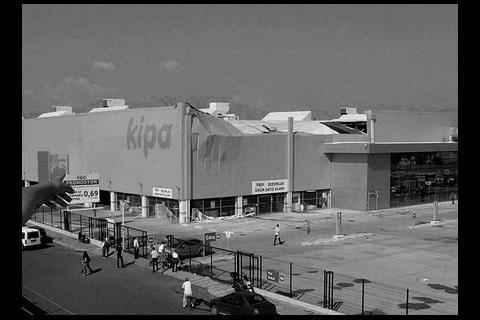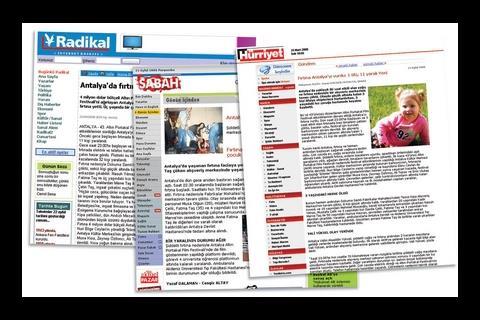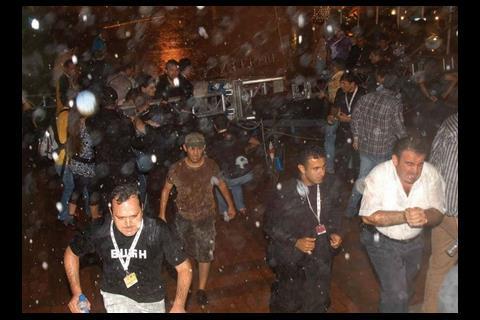In September 2006 a three-year-old girl was killed when the roof of a Tesco store in Turkey caved in. The retail group blamed the collapse on ÔÇśextreme weather conditionsÔÇÖ, but 18 months on, ║├╔ź¤╚╔˙TV has obtained a report filed by senior figures at Tesco soon after that cites poor construction as a major factor in the accident.
On 21 September 2006, with less than a dayÔÇÖs notice, the most senior members of TescoÔÇÖs property and construction team boarded the company jet bound for south-west Turkey.
Once in transit, they sat spread out across the plane, lost in their own thoughts ÔÇô hardly surprising, considering they were on their way to investigate an accident in which a three-year-old girl had been crushed to death.
The plane was heading to the city of Antalya, where a brand new Tesco Kipa hypermarket ÔÇô the Turkish equivalent of one of TescoÔÇÖs largest stores in Britain ÔÇô had partially collapsed eight months after it opened, killing the young girl, Merve Tas.
The official explanation at the time was that it was a tragic accident caused by a terrible storm, and the chief prosecutor for the region is still to complete his analysis of precisely what was responsible. But a report compiled by Tesco shortly after the tragedy, and obtained by ║├╔ź¤╚╔˙TV, reveals the Antalya store suffered from faulty design and poor construction.
Sources close to the event and the report paint a disturbing picture of ad hoc design changes by the building team and botched construction of the 7,000m┬▓ store. These failings, laid bare in the report, when combined with the adverse weather had tragic consequences.
The team on the plane that sombre morning included Tony Vasishta, then TescoÔÇÖs development director, Richard Rust, the construction development manager at the time, Marc Kaya, a Turkish-speaking structural engineer and Gordon Fryett, the group property director.
One senior source told ║├╔ź¤╚╔˙TV that even though the light was failing when the team arrived in Turkey it was ÔÇťblatantly obviousÔÇŁ that poor construction had contributed to the collapse. A trip back to the site the following day confirmed this (see ÔÇťHow the building collapsedÔÇŁ, below).
The report was prepared by Kaya for Vasishta on 9 October 2006, after the team had inspected the building and watched CCTV footage of the incident. It starts by saying the main reason for the teamÔÇÖs visit to Antalya was to ÔÇťascertain deficiencies in the construction of the Kipa storesÔÇŁ. It goes on to detail examples of poor construction, building materials not being up to scratch, cost restrictions, insufficient timescales and a lack of co-ordination and communication between contractors, subcontractors and the design team. It also sets out nine key points to be addressed before the store could reopen and 20 recommendations of works to improve the building.
There were a handful of reports in Turkish newspapers after the incident, but news of the collapse and the childÔÇÖs death never reached the UK press.
TescoÔÇÖs official line since the collapse has been that the storm was the main cause of the accident, but Turkish newspaper articles at the time indicated that MerveÔÇÖs parents blamed the construction of the building for their daughterÔÇÖs death. In one, her father, Cetin Tas, was quoted as saying: ÔÇťSuch a building shouldnÔÇÖt have been made. Why wasnÔÇÖt it checked? Only thin poles were holding up the ceiling of such a big shopping centre. What if this had happened at the weekend?ÔÇŁ
The article also reported that the girlÔÇÖs uncle, Metin Tas, was to sue the construction company ÔÇô the name of which Tesco was unable to confirm ÔÇô and Tesco Kipa, but this never reached the courts. Tesco said an out-of-court settlement had been reached with the girlÔÇÖs parents, which it believed was ÔÇťthe best outcome for both partiesÔÇŁ.
In a statement to ║├╔ź¤╚╔˙TV, Tesco said: ÔÇťThe accident, which happened 18 months ago, was fully investigated by the chief prosecutor for the region and at no stage has he or any of the other Turkish authorities suggested that Tesco was at fault.
ÔÇťThe collapse occurred as a consequence of extreme storm conditions ÔÇô a combination of high winds, heavy rain and hail ÔÇô which damaged our store and other buildings. Although the chief prosecutor has made some findings in relation to responsibility for the collapse, he has not completed his deliberations and therefore it would be inappropriate to comment on these.
ÔÇťFollowing the collapse, Tesco conducted its own investigation using a team of experts from the UK. Their report did identify some issues with the design and construction of the roof but it is clear that these alone would not have caused the collapse without the weather conditions which, while not unique, were among the worst on record for the area.
ÔÇťThe Kipa store met all local building regulations and had been inspected and signed-off by the local municipal authorities at the design stage and prior to opening.ÔÇŁ
How the building collapsed
The store was constructed with a reinforced concrete base and columns. These columns terminated at the base of the roof structure, which was formed from a lattice of lightweight steel. This was topped by a liner sheet, mineral wool insulation and a waterproof, single-ply membrane. The cladding extended from the base of the store to 1m above the roof line.
This design was able to withstand vertical loads but not lateral loads generated by wind pressure above the columns. A report after the disaster said the steel work at the building perimeter and the space frame wasnÔÇÖt adequate to take horizontal loads. As such, strong winds on the day of the disaster caused the edge of the store facing the prevailing winds to deflect inwards, an effect exacerbated by the cladding extending beyond the roofline. This caused a depression to form in the roof adjacent to the edge of the store allowing heavy rain to collect.
Because mineral wool insulation had been used under the single ply membrane rather than a rigid insulation board, the weight of the water could compress it. This in turn allowed yet more water to collect, compressing the insulation further. The report points out that the roof was inadequately drained so the water could not escape quickly enough and began to build up. As the roof sagged, the pooled water dropped below the level of these outlets. Once this combination of pooled water and wind pressure exceeded the load capacity of the roof structure a section measuring about 16 ├Ś 24m collapsed.
Thomas Lane
(See file attached for site plan)
Coverage in the Turkish press
ÔÇťFatima Tas and her three-year-old daughter Merve Tas needed help to emerge from the debris. Merve later died as a result of her injuries. Her father, Cetin Tas, blamed the construction of the building. He said: ÔÇťNo punishment will bring back my smiling daughter.ÔÇŁ
ÔÇťI wouldnÔÇÖt want to be in the position of little MerveÔÇÖs family. I can only guess as to how sorry the management of the store is feeling. After having brought their trademark to the region, theyÔÇÖve met with such a distressing event.ÔÇŁ Columnist
ÔÇťG├╝rcan ├ľnol, Tesco KipaÔÇÖs public relations director, made a statement about the loss of MerveÔÇÖs life. Mr ├ľnol said he was deeply aggrieved, reminding us the storm affected many parts of Antalya, as well as causing the collapse of the roof.ÔÇŁ
Tesco worldwide: the facts
Tesco Antalya
Developer: Tesco Kipa
Contractor: Tesco was unable to confirm
Size: 7,000m2
Cost to build: ┬ú12│ż
Employees in store: 270
Opened: January 2006
Collapsed: September 2006
Tesco acquired Turkish hypermarket chain Kipa in November 2003 for £75m, and renamed it Tesco Kipa. Tesco invested £150m in developing its Turkish presence in 2007. There are now 30 Tesco Kipa stores in Turkey and the group is planning to open a further 49 by the end of 2008.
It will open its first store in Istanbul in May, and hopes to open a second later in 2008. Tesco has stores in 11 countries, including six in Europe and five across Asia.
The report
The aim of the report obtained by ║├╔ź¤╚╔˙TV, ÔÇťCondition Survey and Structural Report on Tesco/Kipa Store at Antalya, TurkeyÔÇŁ, was to investigate any structural problems with the store. It does not draw any conclusions as to the impact of the adverse weather, however it implies that a catalogue of errors contributed to the collapse of the store.
Poor construction and bad communication between those working on the project are highlighted as the main contributors to the tragedy. The report is split into nine main sections, each one detailing a problem with the make-up of the building. These are:
- Drainage
- Lateral restraint
- Roof insulation
- Roof membrane and structure
- Roof access arrangements
- Space frame structural integrity
- Vertical wall cladding
- Quality of concrete
- Maintenance
The report focuses on drainage, lateral restraint, roof insulation, vertical wall cladding and quality of construction.
Drainage
The report says: ÔÇťClearly the drainage system is not functioning as assumed in the design.ÔÇŁ There were not enough downpipes to effectively drain away water, and those that were there were not positioned correctly and did not match up to the design.
For the drainage system to be effective the report says pipes would have to be made larger, repositioned and reduced in height.
Lateral restraint
ÔÇťThe design of the vertical truss around the perimeter and the horizontal support from the space frame was found to be inadequate.ÔÇŁ The report says the calculation of the weight that was going to be exerted on the space frame was too low.
Roof insulation
The report recommends that the original insulation be replaced across the entire roof, as the current layer compressed when it was exposed to rainwater and was not rigid.
Vertical wall cladding
The cladding pulled away from the horizontal channel supports and the fixings ÔÇťappeared to be insufficientÔÇŁ.
Quality of construction
ÔÇťThe quality of construction, insitu concrete works, steelwork and onsite welding is poor in some locations. It is evident that some detailing has lacked design co-ordination between contractors, subcontractors and the design team. There are numerous items of snagging that need remedial action.ÔÇŁ
Conclusion
The final section of the report states: ÔÇťThere appears to have been a number of design variations developed on site or at progress meetings by the project managers, contractor or his subcontactors. This has led to poor and uncoordinated detailing, producing poor construction on site.
ÔÇťInsitu concrete is of poor quality, in particular ground breaking slabs, where steps exist between concrete bays. This indicates differential settlement, owing to missing steel-tie reinforcement and lack of induced or controlled movement joints.
ÔÇťIt is also concluded that many construction details exist that contravene good health and safety practice that will give continuing and short-to-long-term maintenance problems.
ÔÇťIt is possible that suitably qualified and experienced personnel may not have been available at all times during the construction to ensure works are of an acceptable quality.
ÔÇťOther pressures affecting quality of detail and construction may have been because of cost restrictions and an insufficient contract programme period.ÔÇŁ































No comments yet